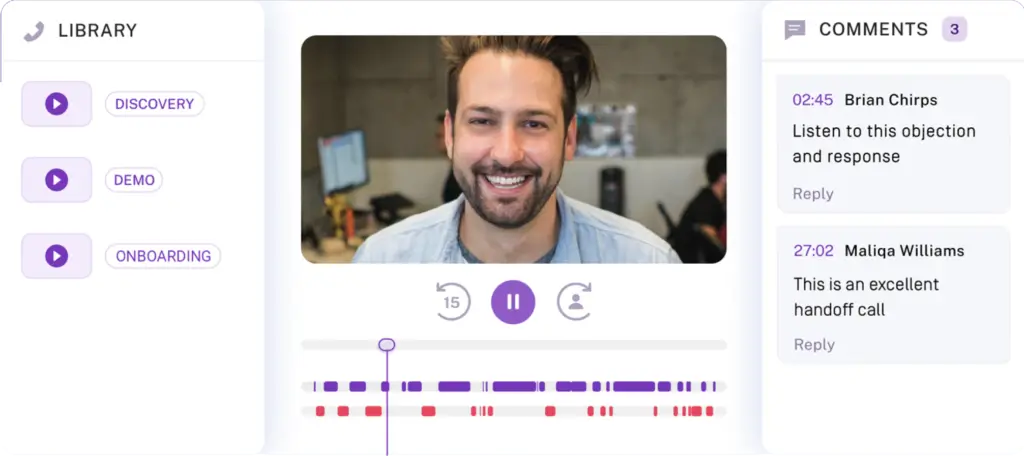Rahim Fazal: From Rap Artist to Silicon Valley CEO

Is organic hyper growth possible?
How can you transition from a self-service to an outbound sales model?
Why is diversity in sales so important?
On a recent episode of the Reveal podcast, we connected with Rahim Fazal, CEO of SV Academy, for answers to these and other questions that are top of mind for revenue leaders.
Key Points to Remember
- Inbound lead segmentation is critical to a successful sales strategy.
- Top of funnel and outbound focus can greatly improve revenue predictability.
- Elitist hiring practices limit access to potentially exceptional sales talent.
Organic Hyper Growth
Like a lot of opportunities in life, it came quite serendipitously. I moved to Palo Alto. I had gotten pretty excited about new models in advertising. Myspace was the big platform at the time. So I started to think about ways I could bring video onto Myspace.
And then all of a sudden Facebook erupted and took off. And the developer platform opened up. It just happened to be that I was in the right place at the right time. Having nothing to do with my life except hang out with my friends, who are a couple of engineers, and start hacking on that platform.
And ultimately, we built a pretty significant enterprise software platform that helped brands, celebrities, and other influencers build Facebook pages in the same way I had helped businesses do that in my first business on Web 1.0.
That time it was in social and it was sort of the same concept. And so made a push button way for all of these pages to get created and populate it with content and other interaction, video, quizzes, and all of this stuff.
Alicia Keys ended up using Involver to launch her album, streaming completely free before it hit the stores and before it hit iTunes. It was all through Involver. We were powering the Facebook pages for the White House. We were powering all of the Olympics and the NFL and even Facebook itself. Facebook, for its various organizations, would use Involver to basically run its fan pages.
And we opened this thing up self-serve, and we would get 500 or 1,000 signups every day completely organically. And I’d learned some stuff from those Web 1.0 days where I would put the link in every account. So every fan page that was using Involver had a little link back to our site.
And that’s how people found out about it. And we built this really beautiful organic inbound channel, which then allowed me to build out a team of SDRs that would sit on top of all of those inbound leads that were coming in, start segmenting them, call them and nurture them, and up-sell them into SMB packages and ultimately into mid-market. We had companies like Nike that would come as free customers. I’d have the more senior BDRs call them and up-sell them into enterprise accounts.
And ultimately that is what got the attention of Oracle. They realized that a number of their big accounts that were using other Oracle products on the commerce and content management side were also now using Involver. Being able to tie all of that in together became a big idea that Oracle ended up investing quite a bit of money behind.
And now the marketing cloud is a pretty substantial part of the cloud business. The product that we had built, that little thing that we started on Myspace and then Facebook, just a handful of people in downtown Palo Alto, is still being sold as part of the marketing cloud offering to big enterprise customers all across the world.
I think [starting my first business in high school] sort of helped me build the confidence in myself to go and tread a non-traditional path. That I didn’t have to follow what all the adults around me, or of what all my friends, were telling me to do.
Building a Sales Strategy on the Fly
I don’t think I truly understood go-to-market. Had I understood it, I think the company would have done even better. I was a very product- and product marketing-centric thinker. And I built a lot of the viral loops and onboarding channels into the product itself, which was a cause for great success at the beginning.
But ultimately, I couldn’t figure out how to properly monetize all this inbound that we were getting. I would talk to anyone who would listen, and I would say, “Do you know anybody who can help me with this problem?”
And I started to get people coming in for interviews for this role of an SDR, which I didn’t really understand anything about. But all these folks were coming from very different backgrounds. None of them had actually done this job before. But I didn’t know any better. And so we would hire the ones that I liked—just really personality more than anything else.
We had segmented our leads pretty typically—SMB, mid-market, and enterprise. SMB for the most part was purely automated nurturing. If they needed any support, they were going to a self-service support system. For anyone that we could identify either had a certain number of followers on Facebook, and we could also then enrich with additional data around revenue and company size, I’d either send to the mid-market team or the enterprise team.
The funny thing is, the enterprise team was just me for the most part. And the mid-market team were a bunch of very junior AEs. At the time they were just really taking orders. There was so much demand for Facebook marketing applications that a CMO would tell their director of marketing, “We gotta do something to get on to Facebook, because that’s where everything is going.”
They’d go on Google and search for it, or they’d go on Facebook and look at competitors’ sites, figure out Involver, and come sign up for free. And then they’d get a call from one of us explaining to them what we could provide them at an enterprise level, which was a layer of sophistication that you could not get for free either through our SMB product or through the Facebook self-serve product at the time. Which gave you a view into your fan page analytics and into the fans themselves.
I never really built that muscle around outbound. And it wasn’t until I got over to Oracle, and I started to make investments in different SaaS companies and leverage the Involver learnings, that I developed a real appreciation for the importance of the SDR/BDR team, and the relationship between that team and the account executives.
I think had I only had the Involver experience and only had the Oracle experience, I would have thought that leads basically fall off trees. And it’s so not the case. Having now supported hundreds and hundreds of SaaS companies across the country, it’s so clear to me the importance of the very top of the funnel, and the importance of outbound, and importance of really thinking very thoughtfully about how you build that part of the funnel out so that you have predictability, throughput, and efficient resource allocation throughout the funnel.
Diversity in Sales
We found this is actually a multi-dimensional problem on the supply side as well as the demand side. It was clear that the profile of individuals that were hired into these rules, including the ones that I used to hire for at Involver because I didn’t know any better, was a pretty homogenous profile of “rich white male lacrosse player.”
So, it started with just a lot of customer development. Understanding the pains of the CEOs, heads of Sales, functional leaders with respect to the availability of sales talent.
And then looking at where the supply was coming from, and realizing that there just wasn’t enough supply. We realized with the higher ed institutions not focusing on sales. And part of it was the employers having these pretty homogenous elitist hiring practices. And if you didn’t fit a particular profile, you may not make it through the recruiting system.
We realized that we could take all of those learnings and apply them to creating a systems change that would be far more exciting than anything we’d ever done before. Because if we could change the future of education, and if we could change the future of work—particularly in the face of increased automation and this disruption we’re seeing in the workforce—through some combination of skills and recruiting, we could change the lives for hundreds and thousands of SaaS companies and tens of millions of job seekers.
Take 100% responsibility for your experience, and be genuinely curious and detached from being right. I think if you can do those two things, you will be a powerhouse.
Subscribe to Reveal: The Revenue Intelligence Podcast
Every week, we interview senior revenue professionals who share their insights on how they leverage revenue intelligence to drive success and win their market.
You’ll hear how modern go-to-market teams win, close revenue with critical deal insight, and execute their strategic initiatives—plus all the challenges that come along with it.
Listen now at gong.io/podcasts.
